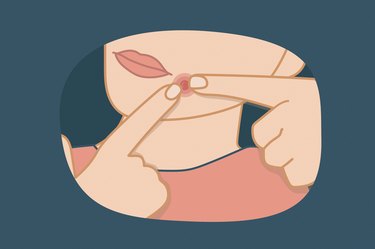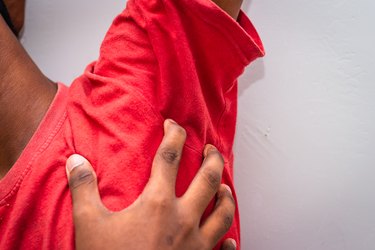
The skin is your largest organ, and its primary job is to provide a physical barrier that protects you from the outside world. But if things don't function as they should, you might start to notice irregular or even unpleasant symptoms like infections, pimples or other bumps and lumps.
While some skin symptoms are nothing to worry about, others might need to be addressed with a health care professional. In some instances, you'll want to get treatment before an issue worsens.
Video of the Day
Video of the Day
That's certainly the case with certain causes of armpit bumps. The tricky part, though, is the various causes can often be mistaken for each other.
Underarm bumps may be due to something as simple as an ingrown hair, but it could also be a sign of something more serious. To get to the root cause of your symptoms and determine the right treatment plan, we asked board-certified dermatologists what to look for and when to see a doctor.
1. Ingrown Hairs
Body hair is natural, but certain cultures normalize getting rid of it. If you shave, wax or otherwise remove your armpit hair, that comes with the risk of ingrown hairs, which can be uncomfortable. Because they're associated with shaving, ingrown hairs are also referred to as razor bumps or shaving bumps, but they're scientifically known as pseudofolliculitis barbae.
Razor bumps can look similar to small pimples, according to the Cleveland Clinic. As the hair grows between shaves, the hair shaft can curl back and penetrate the skin, which causes inflammation, explains Marisa Garshick, MD, a board-certified dermatologist in New York City. When you shave over these ingrown hairs, it can irritate the skin, leaving little red bumps behind.
While anyone who shaves can experience razor bumps, they're most common among people with darker skin, per the American Academy of Dermatology Association (AAD). It's also more common in those with curly or coarse hair, Dr. Garshick adds.
Fix It
Home remedies usually help ingrown hairs clear up. Shaving over razor bumps can aggravate the skin even more, so take a break from shaving until the bumps clear up. Try using a warm compress to soothe the irritated skin.
It’s possible to treat ingrown hairs or razor bumps, but dermatologists recommend preventing them by switching up your grooming routine. To prevent razor bumps, always shave in the direction the hair grows (not against the grain) and use moisturizing shave products, per the AAD.
Regularly replace your razor blades so you're not shaving with a dull blade, Dr. Garshick adds. If your budget allows, you might also consider laser hair removal, which typically reduces your number of ingrown hairs, according to the Cleveland Clinic.
2. Acne
Acne is most common on the face, chest and back, but it can also pop up in the underarm area, says Brendan Camp, MD, a board-certified dermatologist in New York City. There are different types of acne, caused by a number of factors. The most common causes of acne are bacteria, excess oil, clogged hair follicles and skin inflammation, Dr. Camp says.
You can get acne at any age anywhere on the skin where there are oil glands present. The armpits have oil glands, so they're fair game for the occasional pimple.
Fix It
Acne is very responsive to over-the-counter (OTC) treatments, Dr. Camp says. He recommends looking for washes with active ingredients that fight acne, such as salicylic acid or benzoyl peroxide.
If your underarm pimples don't clear up with an acne wash, Dr. Garshick recommends seeing a dermatologist. They might prescribe a topical cream or oral medication to treat more severe underarm pimples.
3. Folliculitis
If you suspect your case of underarm bumps is acne but the pimples don't go away with OTC treatment, folliculitis is usually the next cause to rule out.
The problem is the red, pus-filled bumps caused by folliculitis — a common skin infection of hair follicles, according to the AAD — look a lot like acne, Dr. Camp says. It also doesn't help that there's usually inflammation involved, which can mimic ingrown hairs, too.
There are a few ways bacteria can get into a damaged hair follicle and cause folliculitis bumps, Dr. Garshick says. You might damage the follicle by shaving, wearing tight-fitting clothing that cause friction or lounging a little too long in your sweaty clothes post-workout, for example.
Folliculitis is common, and anyone can get it, but you're more at risk if you have a weakened immune system or other skin infections, if you have opens cuts or scrapes or if you've spent time in a hot tub recently that wasn't treated properly, according to Cedars Sinai.
Fix It
In mild cases, folliculitis can go away on its own. Applying a warm compress on your underarms a few times per day may help the damaged skin follicle recover more quickly.
Dr. Camp also recommends using topical antibacterial treatments, such as benzoyl peroxide washes, to help clear things up.
In some cases, a prescription-strength treatment with antibiotics may be necessary.
4. Hidradenitis Suppurativa
Hidradenitis suppurativa (HS) is a lesser-known cause of underarm bumps, Dr. Garshick says. It typically occurs where skin touches skin, so the armpits are a prime spot for this issue to pop up.
HS also goes by the name acne inversa, and, unsurprisingly, it can be mistaken for acne. It's not a type of acne, however. The bumps appear more like lumps, and they can be painful, drain pus and heal slowly, according to the Mayo Clinic. When they aren't treated properly, the lumps can lead to scarring.
Black people and people assigned female at birth are more likely to develop HS, per the Mayo Clinic.
Fix It
HS is a chronic skin condition, so there’s no cure, Dr. Camp says. But it can be managed with the right treatments. Talk to your dermatologist about the best treatment plan for you, which may include medicated cleansers, topical antibacterial creams and oral antibiotics. Your doctor might also recommend steroid injections, Dr. Garshick adds.
5. Swollen Lymph Nodes
If your armpit feels swollen or you notice a lump, it could be your lymph nodes at work.
Lymph nodes are part of the lymphatic system, which is part of your immune system. Their main function is to help filter out foreign substances and fight infection, according to the American Cancer Society.
There are hundreds of lymph nodes throughout your body, including in the underarm area, and sometimes they become swollen or enlarged. You might hear a doctor refer to this using the medical terms axillary adenopathy or axillary lymphadenopathy. If you have swollen lymph nodes, you might feel noticeable bumps or lumps in your armpits, Dr. Garshick says. You may even be able to move the lumps with your fingers, per the Cleveland Clinic.
Lymph nodes don't swell on their own, so there's always an underlying cause. The most common cause is infection, according to Mount Sinai, though certain autoimmune diseases, cancers and medications can also cause swollen lymph nodes.
It's important to keep in mind swollen lymph nodes often are not an indication of cancer, per the American Cancer Society, so don't jump to any conclusions. Anyone can experience them, though these lumps in your armpit are more common in people prone to infection and those with lupus, according to the Cleveland Clinic.
Fix It
Swollen lymph nodes are common, and they’re not always a bad thing, per the Cleveland Clinic. This could be a sign that your immune system is working as it should to fight off an infection. In many cases, the swelling will go down within a couple of days.
When swollen lymph nodes persist, it’s a good idea to see your physician, Dr. Camp says. Swollen lymph nodes shouldn’t feel hard or tender to the touch, so if the area is firm and painful, you may need to be evaluated by a health care professional.
6. Cysts
Noticing a new lump anywhere on the body can be alarming. Lumps that feel deep under the skin — but that you can still touch — may be cysts. These round lumps may be filled with pus or other fluid, and in some cases, they can be painful. Cysts commonly form under the skin, but most of them aren't cancerous, per Harvard Health Publishing.
There are hundreds of different types of cysts, but epidermoid cysts and pilar cysts are among the most common. Both form around hair follicles, according to the Cleveland Clinic, and when hair follicles get clogged with keratin and skin cells, cysts can form in the underarm area. Shaving can also cause armpit cysts, according to the National Library of Medicine, as can antiperspirant (but deodorant shouldn't), per Mount Sinai.
Fix It
Painless cysts often go away on their own, or they don’t require treatment. It can be helpful to see a doctor to make sure an armpit cyst is benign and assess options for treatment if your cyst bothers you. Some cysts filled with pus or liquid can be drained or treated with antibiotics while others require surgical removal.
When to See a Doctor
Many cases of underarm bumps clear up on their own or with home remedies, but others could warrant a trip to your doctor or dermatologist.
Always talk to a professional if your symptoms don't improve with OTC treatments or home remedies. They might run tests to identify any bacteria causing your symptoms or prescribe a topical or oral medication. And you should always talk to your doctor if you have a lump in your armpit and other symptoms like fever or excessive fatigue.
- Cleveland Clinic: “Razor Burn”
- AAD: "6 razor bump prevention tips from dermatologists"
- AAD: "Razor bump remedies for men with darker skin tones"
- AAD: "Acne-like breakouts could be folliculitis"
- Cedars Sinai: “Folliculitis, Boils, and Carbuncles”
- Mayo Clinic: "Hidradenitis suppurativa"
- American Cancer Society: “Lymph Nodes and Cancer”
- Cleveland Clinic: "Armpit Lump"
- Harvard Health Publishing: "Cysts (Overview)"
- National Library of Medicine: “Armpit lump”
- Cleveland Clinic: "Swollen Lymph Nodes"
- Mount Sinai: "Swollen lymph nodes"
- Mount Sinai: "Armpit lump"
- Cleveland Clinic: "Ingrown Hair"
Is this an emergency? If you are experiencing serious medical symptoms, please see the National Library of Medicine’s list of signs you need emergency medical attention or call 911.


